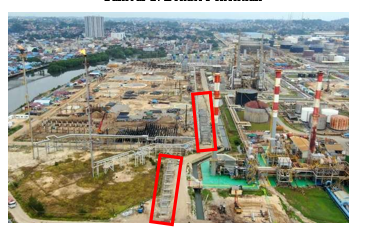Optimalisasi Penggunaan Alat Berat Pada Pekerjaan Pondasi Proyek Interconnecting Pipe Rack Foundation Pertamina RDMP RU-V Balikpapan
Main Article Content
Abstract
Most of the construction in the construction sector, such as building construction, bridges, highways, construction of dams uses heavy equipment. One of the Pertamina RDMP RU-V Balikpapan projects will carry out pipe rack foundation work with heavy equipment that will be used for this foundation work.
The research method used in this research is descriptive quantitative analysis method.
The results of the calculation show the productivity values of each heavy equipment, namely: (1) the productivity of excavators is 99,450 m3/hour, 102 m3/hour, 128,323 m3/hour and 126,621 m3/hour. (2) Dump truck productivity is 13,031 m3/hour, 13,222 m3/hour and 15,017 m3/hour. (3) The productivity of rough terrain crane is 98.077 m3/hour. (4) Baby roller productivity is 76,775 m3/hour. The total time required for heavy equipment in this work is 88 hours with a total cost of all the tools used of IDR.48,682,000,-. The cost of each tool, namely: (1) IDR.21,188,500,-for the excavator. (2) IDR.11.672.000,-,- for dump trucks. (3) IDR.2.571.000,- for rough terrain crane. (4) IDR.13.250.000,- for baby roller. The results of the analysis of the most efficient alternative in terms of time and cost are alternative 3. This work can be completed within 59 hours with a total cost of IDR.38.832.000.-.
Downloads Statistics
Article Details
References
[2] Kementrian Pekerjaan Umum. 2013. “Katalog Alat Berat Konstruksi”. Jakarta: Pusat Pembinaan Sumber Daya Investasi Badan Pembinaan Konstruksi Kementerian Pekerjaan Umum Jakarta Selatan.
[3] Kholil, Ahmad. 2012. “Alat Berat.” Bandung: PT. Remaja Rosdakarya.
[4] Muin, Syamsir A. 1990. “Pesawat-Pesawat Pengangkat” - Edisi ke-1 Hal. 213. Jakarta: CV. Rajawali.
[5] Purworini, Ardiana. 2016. “Tugas Akhir Analisa Waktu dan Biaya Penggunaan Alat Berat pada Pembangunan Gedung Condotel Proyek Sahid Jogja Lifestyle di Yogyakarta.” Surabaya: Jurusan Teknik Sipil, Fakultas Teknik Sipil dan Perencanaan Institut Teknologi Sepuluh Nopember Surabaya.
[6] Putra, M. Irfan Hari. 2018. “Analisis Pemilihan Alat Berat pada Pekerjaan Galian dan Timbunan Proyek Pembangunan Fakultas Hukum UII (Heavy Equipment Choice Analysis on Cut and Fill Work of UII Law Construction).” Yogyakarta: Fakultas Teknik Sipil dan Perencanaan, Universitas Islam Indonesia.
[7] Ramadhani, Afifah. 2017. “Optimalisasi Penggunaan Alat Berat pada Pekerjaan Galian Tanah di Proyek Tol Nganjuk – Kertosono”. Malang: Fakultas Teknik, Universitas Brawijaya.
[8] Rochmanhadi. 1987. “Alat-Alat Berat dan Penggunaanya.” Jakarta: Yayasan Badan Penerbit Pekerjaan Umum.
[9] Rostiyanti, Susy Fatena. 2002. Alat Berat untuk Proyek Konstruksi. Padang, Sumatera barat: Rineka cipta.
[10] Rostiyanti, S.F. 2014. “Alat Berat Untuk Proyek Konstruksi” – Edisi ke-2. Jakarta: Rineka Cipta.
[11] Tenriajeng, Andi Tensirukki. 2001. “Pemindah Tanah Mekanis”. Jakarta: Gunadarma.


 https://doi.org/10.32487/jutateks.v5i1.326
https://doi.org/10.32487/jutateks.v5i1.326
